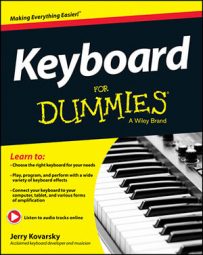Put a few keyboard notes together and you have a chord. Basic chords (called triads) are built on three notes: the root (the name of the chord), the third, and the fifth. These names refer to the note's step location in the scale of the same name (the third note of the scale, the fifth note of the scale, and so on). But basic chords are just the beginning; the following sections introduce you to seventh chords and sixth chords and then show you how to figure out which you're actually playing.
Adding a fourth note: The seventh chord
To play most styles of music, you need to know about the four-note chords called seventh chords. They add richness to your playing and take you from basic to pro. Whereas basic triads stack intervals of thirds on top each other (root, third, and fifth), seventh chords continue the next logical step and stack another third on top of the triad, which forms the seventh.
Playing and hearing the six basic seventh chords
There are a few different types of seventh chords, each having a sound quality of its own. Some are more peaceful sounding; others produce tension that adds to the drama and energy of the music.
The major seventh chord
If you take a major triad and stack another note a major third higher from the fifth (four half steps), you get the major seventh chord (shown in Figure 1, Example 1).

Play the chord and listen to how it sounds. It sounds even more peaceful than the major triad, right? Example 2 in Figure 1 shows the four inversions of the major seventh chord. Inversions are the same notes of a given chord, rearranged so different notes are on the bottom and top.
The major seventh chord is commonly written as a letter with a capital M plus 7 after it (CM7), but may also be written as CMaj7 and sometimes C∆7, mostly in jazz charts and fake books (jazz songbooks that only have the melody and chord symbols).
The minor seventh chord
If you take a minor triad and add a note a minor third (three half steps) above the fifth, you get the minor seventh chord (see Figure 2). It sounds similar to the minor triad, with just a little extra "color" added.

The minor seventh chord is commonly written as a letter with a small m7 after it (Cm7), but may also be written as C-7, mostly in jazz charts and fake books.
The dominant seventh chord
If you take the major seventh chord and lower the seventh by a half step, you get the dominant seventh chord (shown in Figure 3).

Play this chord over and over, and it sounds like rock and roll piano. This chord is important for its function in harmony and chords progressions. The dominant seventh chord is commonly written as a letter with a 7 after it (C7).
The diminished seventh chord
A diminished chord with another note a minor third higher (three half steps) is the diminished seventh chord (refer to Figure 4). Although the seventh should be written with a flat, doing so would make it a B-double-flat; for easier reading, you can use the enharmonic name of A.
Enharmonic means the same note/pitch can have more than one name, usually the choice of a sharp or flat name (F-sharp and G-flat, for example). Sometimes it can be between a natural note and a note with sharps or flats, or even double sharps/flats, as in this example.

Play the chord; it is even more suspenseful and tense than the triad version. It has a strong function in harmony. The diminished seventh chord is commonly written as a letter with a small circle and a 7 after it (Co7) but may also be written as Cdim7.
The augmented seventh chord
Think of the augmented seventh chord as a dominant seventh chord with the fifth raised a half step (see Figure 5).

The augmented seventh chord is also called a dominant seventh/sharp five chord, commonly written as C7+ and sometimes shown as Caug7, C7#5, or C7+5. It serves the same harmonic function as a dominant seventh chord but is a little more exotic and not for just pounding out rock and roll. It's an even more colorful way to play an intro for a singer.
The sus2 and sus4 seventh chords
The sus4 chord usually acts as a variation of the dominant seventh, so it has the lowered seventh chord tone (three half steps above the fifth). Figure 6 shows the chord and its inversions. The sus chord is sometimes used as an open, floating sound that can imply major or minor tonalities.

The sus4 chord is commonly written as a letter plus a 7, followed by sus4 or sus, with or without parentheses: C7sus4, C7(sus4), or C7sus.
The sus2 chord rarely gets a seventh added to it, and there are no common chord symbols to indicate it. The sound of a sus2 chord with an added major seventh can be interesting, but only in the root and first inversion chord shapes. See Figure 7 for this extra cool chord.
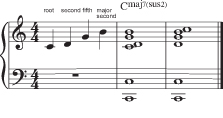
Recognizing the major scale seventh chord tones
If you take the major scale and build up seventh chords for each scale tone you get the chord qualities shown in Figure 8.

You can see major seventh chords for the I (1) and IV (4) chords; the ii (2), iii (3), and vi (6) chords are minor sevenths, and the V (5) chord is a dominant seventh.
In a major scale, the vii chord is a variation called a half-diminished chord, where the seventh is a major third, or four half steps, above the fifth. The fully diminished seventh chord comes from the minor scale.
You can play plenty of songs using only these scale tone chords. Figure 9 uses a set of chords that are very common in doo-wop songs from the '50s and early '60s. The figure presents them with close inversions for smooth movement between chords and offers two variations of the chord progression: Ex. 1 uses the ii chord (Dm7), and Ex. 2 uses the IV chord (F major 7).
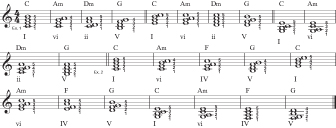
Not all songs in a given key choose to follow these scale tone chord rules, especially in rock-and-roll and in the blues. The common chord progression for playing the blues uses the I, IV, and V chords. If you want to add sevenths to the chords, you should make them all dominant sevenths. Using major sevenths for the C (I) and F (IV) chords would sound completely wrong! See Figure 10 for both the wrong and right versions.
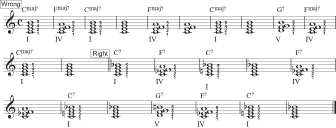
Playing two-handed seventh chords in a pianistic approach
Spreading out your chords across both hands sounds great when you're using an acoustic or electric piano sound. Not every chord needs to be a seventh; sometimes it's nice to mix them up with some triads for variety. Play through Figures 11 and 12 to see how this can sound. Work out your own fingerings for these examples.
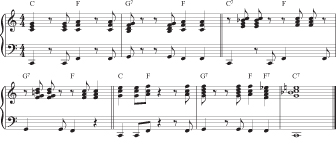
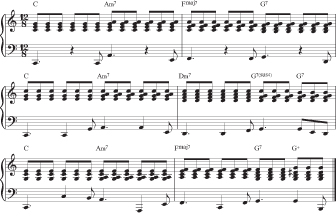
Playing four note seventh chords in your left hand
If you're playing an arranger keyboard or digital piano with auto-accompaniment features, you can play four-note seventh chords in your left hand. For other keyboards, you need to be careful not to play them too low, or they'll sound muddy and unclear. It also depends on what sound you're using. Figure 13 shows a few of the progressions from the preceding sections voiced for the left hand.
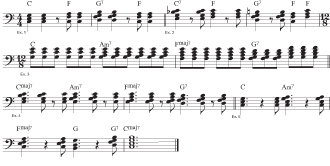
Understanding a few basic rules of harmony
Rules? Rock-and-roll doesn't play by the rules! However, knowing a few about harmony can really help you. The most common and important rule is that the V chord wants to resolve back to the I chord. This tenet is especially true when the V is voiced as a dominant seventh. A tension in the dominant seventh chord wants to move to more peaceful tones in the I chord. And that I chord can be major or minor. See Figure 14 for examples.
Some intervals, such as the octave, sound fine by themselves; they are open and peaceful sounding, which is called consonance. Other intervals sound more unsettled; the best example would be the flatted fifth (six half steps). They are said to be dissonant. In a given key, you can move those dissonant notes to adjacent notes to remove the tension and return to a peaceful sound. When these intervals occur within a chord, the same thing happens; the more tones you add that produce this tension, the more the chord pulls your ear to want to return to scale-tone sounds that sound consonant. That movement is called resolution.
The 3rd and the 7th of the dominant chord (in this case, the B and F of the G7 chord) resolve nicely into the root and third of the I chord (the E and C of the C chord). Or the E-flat and C in the case of a C minor chord. Play them and hear how natural and familiar that movement is.
With this knowledge, you can observe and understand times when a song in a given key has some chords (and notes) that are outside the key signature. A great way of setting up the next chord or making a transition between two chords is to use this guideline. Find the dominant seventh chord that would resolve into the next chord and use it between the two chords. See Figure 15 for a few examples.

In Example 1, the C goes to an Am. The V chord in the key of A is an E, so you can use an E7 to set up the Am nicely. In Example 2, a C7 acts as the V to lead into the F chord, so changing the Cmaj7 to C7 does the trick.
Another important idea is that the diminished chord also wants to resolve. Because it acts as a vii chord, it wants to resolve up a half step. In Figure 16, Example 1, you have a Bdim7 resolving to a C. It has the same B and F notes as the G7, and they want to resolve to C and E. Plus it has a D and A-flat, which want to resolve to an E and G, respectively. So it has a sort of double tension that makes it even more dramatic than the dominant seventh.
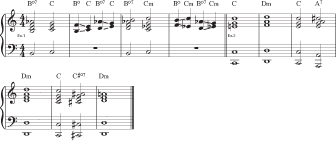
In Example 2, you have a C triad going to a Dm triad. You can use an A7 to set it up, but compare that to using a C♯dim7. It has a different sound, which may be just what you need.
Sixths: Using another type of four-note chord
If you add a note that's a whole step (two half steps) above the fifth in your triad, you get what's called a sixth chord. Root-third-fifth-sixth. The following sections describe the only two versions you need to know.
The major sixth chord
If you take a major triad and add the whole step above the fifth (two half steps), you get the major sixth chord (shown in Figure 17).

The major sixth chord is commonly written as a letter plus a 6 after it (C6). Play the chord and listen to how it sounds. It sounds very much like the major triad in that it's happy and peaceful, but it also has a little more color.
The major sixth chords function well as a I and a IV chord in a major key (for example, C6 and F6 in C major).
The minor sixth chord
If you take a minor triad and add the whole step above the fifth (two half steps) you get the minor sixth chord (see Figure 18).

It sounds similar to the minor triad, with just a little extra "color" added. The minor sixth chord is commonly written as a letter with a small m6 after it (Cm6).
The minor sixth chord functions well as a i and a iv chord in a minor key (for example, Cm6 and Fm6 in C minor).
Which chord is right?
The major sixth chord has the exact same four notes as a minor seventh chord formed on the sixth note. So C6 (C, E, G, and A) uses the same notes as Am7 (A, C, E and G); check out Figure 19 for an example. This similarity can cause confusion when you start using inversions: What's the right bass note? Your chords will always sound fine, but what is the root? The answer tends to come from the key signature or key center. When you want to resolve to the I chord, you may add the sixth, but you want that C root to say, "This is the end." Using the A sounds like you're still moving the harmony around and haven't finished yet.
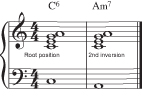
The problem comes up when you play either of these two chord types on an arranger or other auto-accompaniment keyboard. The system doesn't always know which way to interpret what you're giving it to give the right bass note. To solve this issue, arrangers don't usually allow sixth chords until you choose a specific setting for your Fingered/Multi/Standard mode of chord recognition. And playing sixth chords is never supported in the easy fingering option.
Look in your owner's manual for information about the fingered chord choices. Each brand usually has a setting that allows you to use sixth chords and others that always treat sixth chords as their related minor seventh chords.

